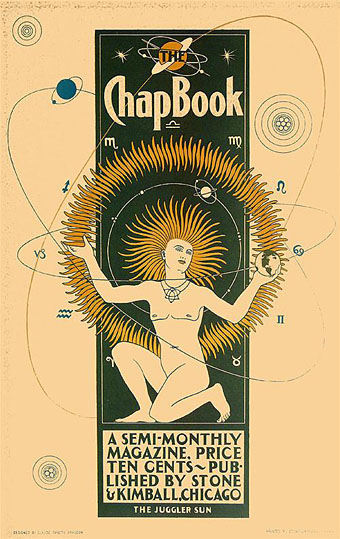Life magazine for August 5th, 1909, with an illustration by Coles Phillips.
02009? Read this.
Happy new year!
A journal by artist and designer John Coulthart.
Illustrators
Life magazine for August 5th, 1909, with an illustration by Coles Phillips.
02009? Read this.
Happy new year!

The Juggler Sun (1895).
On the shortest day of the year it seems fitting to post a picture of the sun and hope that in 2009 the clouds clear long enough for us Brits to see more than a month of it. Claude Fayette Bragdon’s poster is a remarkably stylised work for 1895 and might easily have been produced twenty or more years later. The Chap-Book was a periodical which included Bragdon among its illustrators although none of the cover designs to be found online are this striking. Bragdon wasn’t only an illustrator, however.
A man of many talents, Claude Fayette Bragdon (1866–1946) was an architect, artist, writer, philosopher, and stage designer. Bragdon’s work in these varied fields interrelated and overlapped, tied together by his theosophical belief in creating and communicating beauty. After a successful career as an architect in Rochester, NY, Bragdon entered the world of stage design in 1919, at the age of 53, by consenting to design a traveling production of Hamlet for actor-producer and personal friend Walter Hampden. Bragdon’s arrival in the world of theater came at a time when significant changes in staging techniques were on the horizon. (More.)
I usually celebrate polymathy but in Bragdon’s case his varied interests seem to have deprived us of more work by a unique illustrative talent. The indispensable VTS has further examples of his clean style from a 1915 treatise on architecture and design, Projective Ornament. It was increasingly common during this period to regard ornamentation in architecture as a 19th century evil to be purged from all future buildings, a concept expressed most notoriously by Adolf Loos in his 1908 essay, Ornament and Crime. Bragdon engaged with the argument by proposing that architects put aside historical and natural pastiche and look to geometry for a new style of decoration. His illustrations in Projective Ornament are beautifully done and some (like the one below) might almost be the work of an Art Deco illustrator such as George Barbier.
Elsewhere on { feuilleton }
• The illustrators archive
Previously on { feuilleton }
• The Decorative Age
• Images of Nijinsky
Okay, not really, but we can dream. From A Very Haeckel Christmas at Flickr. Haeckel’s original plates are now at Flickr also. Via DO.
Previously on { feuilleton }
• The art of Ying-Yueh Chuang
• The art of Jennifer Maestre
• Kirsten Hassenfeld’s paper sculptures
• Darwin Day
• The glass menagerie
Poster by Glen C Sheffer (1933).
The image galleries at Yale University’s Beinecke Rare Book & Manuscript Library have been garnering justifiable attention recently for the quality of their collection. Among the groupings, the World’s Fairs and the Landscapes of the Modern Metropolis section immediately caught the attention of this exposition and world’s fair fan. An amazing collection of posters, exposition booklets, photos and plans, many of which augment the subjects of previous postings including the 1900 Exposition Universelle. A very brief and cursory selection follows.
A posting of Dugald Stewart Walker’s work this week at the always excellent Golden Age Comic Book Stories sent me back again to the Internet Archive to see if there might be further examples among their collection of scanned library books. Sure enough there’s not only a copy of the book which GACBS sampled from, Padraic Colum’s The Girl Who Sat By The Ashes, but also other fairy tale collections by Colum, including the one featured here, The Boy Who Knew What the Birds Said (1918). Colum is well-represented in the Internet Archive’s American Library section and many of his titles seem to be at least partly illustrated. A cursory glance at some of the others turned up his retelling of Greek myths illustrated by Willy Pogány.
I’m not as keen on Walker’s work as I am other artists of this period—he has a tendency to give his adult characters gnome-like features—but the line work and compositions are first class. The Boy Who Knew What the Birds Said is especially nice for its many peacock details, some of which are featured below.
left: Bloom-of-Youth and the Witch of the Elders; right: What the Peacock and the Crow Told Each Other.
Elsewhere on { feuilleton }
• The illustrators archive
Previously on { feuilleton }
• Peacocks
• Willy Pogány’s Parsifal